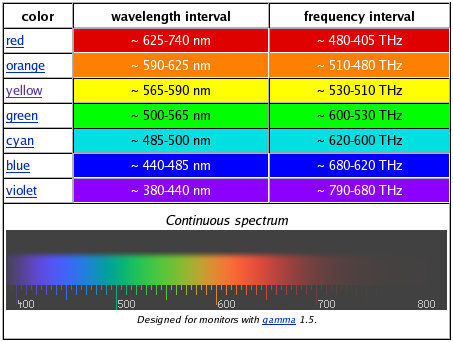|
To understand what color is, we first need to understand what light is. Light, as perceived by humans, is simply electromagnetic radiation with wavelengths between roughly 380 nm and 740 nm. Wavelengths below 380 nm and above 740 nm cannot be seem by the human eye. Electromagnetic radiation with a wavelength just below 380 nm is known as ultraviolet radiation. Electromagnetic radiation with a wavelength just above 740 nm is known as infrared radiation. The sun, black lights and fluorescent lamps are all sources of ultraviolet light. Heat is a source of infrared radiation, which is how thermal vision works. Electromagnetic radiation between the wavelengths of 380 nm and 740 nm constitute light and the human color-vision spectrum. There is evidence that other animals, namely insects and birds, have a color-vision spectrum that extends further into the ultraviolet range. Evolutionary factors greatly influence the development of color vision in different animals and species. Although the human color-vision spectrum is continuous, it can be broken down into discrete ranges of colors which are then labeled with specific names. Here is a simplistic chart of electromagnetic wavelengths and their associated color names:  Table from: http://en.wikipedia.org/wiki/Color Surfaces gain the appearance of color based on their reflection and absorption of different wavelengths of light. A surface that reflects all wavelengths of light appears to be white. Conversely, a surface that absorbs all wavelengths of light appears to be black (and also heats up as a consequence of absorbing this electromagnetic radiation). If a surface does not reflect all wavelengths of light equally, it will appear as a color in the human color-vision spectrum. | |
| << Front Page | Color Vision >> |